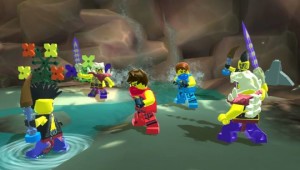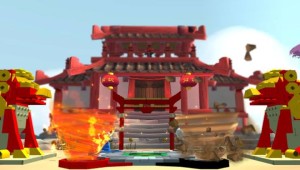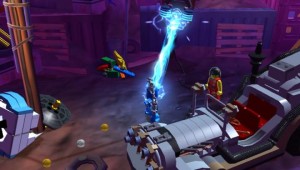Liverpool Sound and Vision Rating 9 out of 10
LEGO Ninjago: Shadow of Ronin is an action adventure platform game available from retail stores and for download from the PlayStation Store for the PS Vita. The game originated in 2011 with a pilot film and a range of LEGO sets which became so successful that it launched its own large scale LEGO brand with over 100 LEGO sets, multiple games including the prequel to Shadow of Ronin in the form of Summer 2014’s Nindroids on Vita, while there are numerous graphic novels, a LEGO Ninjago: Masters of Spinjitzu television series and films taking the franchise considerably further into the future to even greater success.
The story revolves around Kai, Zane, Cole, Jay and Lloyd having their memories and powers stolen by the villainous Ronin with the help of his dark shadowy army of ninjas resulting in a quest for the good guys to get their memories and powers restored, while attempting to prevent Ronin from using the ancient and incredibly powerful Obsidian Weapons to destroy Ninjago.
The game includes 10 chapters consisting of 3 levels per chapter for a total of 30 levels with classic LEGO gameplay such as deconstructing particular obstacles, machinery or statues and constructing a ladder or something that is capable of being utilised to reach the next area, while there are also scrap build mini-games which requires the player to pair the correct item from an inventory list with the highlighted component of the scrap build in order to complete it and obtain the item.
There are five objectives per level to attain the highest score and best performance which are referred to as gold bricks with the objectives involving completing the level, collecting a certain amount of LEGO studs which are effectively the in-game currency, finding a particular number of collectables and achieving two objectives that relate to the specific level such as finding three toxic frogs and freezing three gingerbread men in The Toxic Bogs level.
The free play mode allows the player to revisit each completed level in any order in an attempt to not only complete the incomplete objectives from the first playthrough of each level, but to utilise the skills of each unlocked character by switching to characters that cannot be used during story mode, therefore attempting to find which character’s abilities hold the key to progressing beyond a tricky puzzle and finding out what is hidden beyond it.
The in-game shop menu includes a range of 113 unlockable characters with some being available from the beginning and some unlocking as the player naturally progresses through the game, while the vast majority of the characters can be purchased with the LEGO studs ranging from prices of 10,000 LEGO studs for Ed to 100,000 for Spitta or Lasha and even as high as 250,000 for Anacondrai Warrior and 500,000 for Zumo; 10 unlockable extras; concept art of 10 different areas from the game; and a cutscene viewer of all 22 cutscenes which tell the story, alongside a range of 10 codes to be entered in order to unlock further secrets.
The character design is excellent as it is very faithful to what players would anticipate from a LEGO game as every character has their own unique personality in regards to how they approach situations, alongside a range of melee attacks such as nunchucks, swords, punches, kicks and much more besides and powers as well as a collective team focused multi-elemental power called the Tornado of Creation.
The environment design reflects that of the LEGO Ninjago: Masters of Spinjitzu television series with such imaginative locations including the Ice Temple, the Toxic Bogs and Chen’s Island which are all as faithfully recreated as the characters, while there are even some areas which can be explored on vehicles across land or air with dragons, jets and bikes.
The controls are well mapped to the Vita with the control scheme consisting of pressing X to jump or pressing X quickly twice to double jump; pressing O to interact with an object or to perform a range attack, build or use; pressing triangle to switch from controlling one character to a nearby character or holding triangle to enter the character wheel; pressing square to perform a melee attack or holding square to perform Spinjitzu; pressing X and square together to perform a jump slam attack; pressing L to perform a dash attack; pressing R to cycle through characters; changing the direction of the left analogue stick or alternatively pressing up, down, left or right on the d-pad to move your selected character; and pressing start to display the pause menu.
The touch screen is appropriately utilised as an alternative control scheme with a simple tap of the touch screen on a breakable object or enemy to perform a melee attack; tapping the touch screen just ahead of the chosen character to walk in that direction or far ahead to run in that direction; tapping the second on-screen character to swap control between the two characters; and multi-touch by tapping the touch screen with two fingers to jump or multi-touch twice in quick succession to double jump, while a further use of the touch screen is dragging the required component from the inventory list over to the scrap build.
The graphics possess excellent character models and animations with graphical effects showcasing the true power of the weaponry at hand to both the good and villainous ninjas, while everything in the world and the characters have a charming appeal to them as they are all made entirely from LEGO with some great lighting and shadows cast upon them.
The presentation of the game is solid with a great touch screen based user interface across various menus such as the main menu, map selection, extras, shop, options and gameplay menus with support for navigation via the left analogue stick, directional pad and face buttons, although it does not include support for navigation via the right analogue stick and rear touch pad. The background of the menu screens consists of a sunset shining upon a castle and its surroundings with a wheel cycle in the style of an ancient scroll presenting the available options and menus.
The characters have a quirky humour to them with personalities brought to life by a talented voice-over cast, while the sound effects include attacks from the ninjas against their enemies and Ronin’s army attacking the ninjas as well as ambient sound effects such as volcanic eruptions, alongside a mixture of rock music and ancient Chinese music provides the soundtrack.
The trophy list includes 35 trophies with 20 bronze, 9 silver, 5 gold and 1 platinum trophy. Around half of the trophies can be earned naturally during the first playthrough as there are 14 story based trophies including a bronze trophy for completing each of the 10 chapters and the Scrap That bronze trophy for completing all 4 Scrap Builds, while there are also 9 trophies related to collectibles including 5 silver trophies and 1 gold trophy for unlocking characters with 3 gold trophies for completing the True Ninja, Collector and all challenges, alongside trophies for defeating enemies such as the Martial Arts Experts silver trophy for performing 50 finishing moves and the I Know Spinjitzu silver trophy for defeating 100 enemies with Spinjitzu. It is estimated that depending upon skill and a good trophy guide to provide some helpful tips that it would take between 8 to 12 hours to platinum the trophy list.
There are no difficulty levels resulting in the difficulty curve being only as hard as the player would find the puzzles and combat, therefore it is most likely that players would generally find the game relatively easy to progress through which is rather appropriate given the appeal of LEGO to a wide audience and age range from young children to adults.
There is no local or online co-operative multiplayer and online leaderboards which is surprising as the local co-operative multiplayer could have featured pass the Vita gameplay for players to share the experience with a friend to see who could gain the highest score and last the longest before the character was killed, while online co-operative multiplayer could have had two or more players playing through the story mode together. The online leaderboards could have featured the quickest times from every player who had completed each level and the entire game in single player or co-operatively with further leaderboards for defeating enemies with Spinjitzu and combat related moves, the amount of LEGO studs collected and the amount of challenges completed.
The replayability of LEGO Ninjago: Shadow of Ronin includes replaying levels to collect something or survive a scenario which players failed to do so during the previous playthrough in order to collect the 5 gold bricks from each level by completing every objective, while revisiting levels in free play mode as different characters that have been unlocked with different abilities and attempting to find which character can solve a puzzle and unlock whatever may lay beyond it. There is a natural satisfaction of collecting LEGO studs as well as deconstructing particular objects and constructing an item that is of use to reach the next area of the level.
Overall, LEGO Ninjago: Shadow of Ronin is an excellent LEGO game and certainly fulfils the quality and originality that players would anticipate from a LEGO game, therefore if you are a fan of LEGO in general or of the LEGO Ninjago: Masters of Spinjitzu television series, then this is certainly a must play game, although the same can also be said for players who appreciate a solid experience within the action, adventure or platform genres which are combined and work in perfect harmony.
Jason Bonnar
Analysis
- Title: LEGO Ninjago: Shadow of Ronin
- Developer: Travellers Tales
- Publisher: Warner Brothers Interactive Entertainment
- System: PS Vita
- Format: PS Vita Card/PSN Download
- Cross-Buy: No
- Cross-Play: No
- Players: 1
- Memory Card Space Required: 1.8MB (PS Vita Card)/1.3GB (PSN Download)


